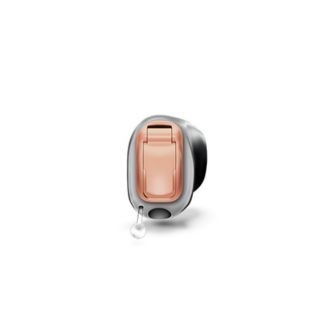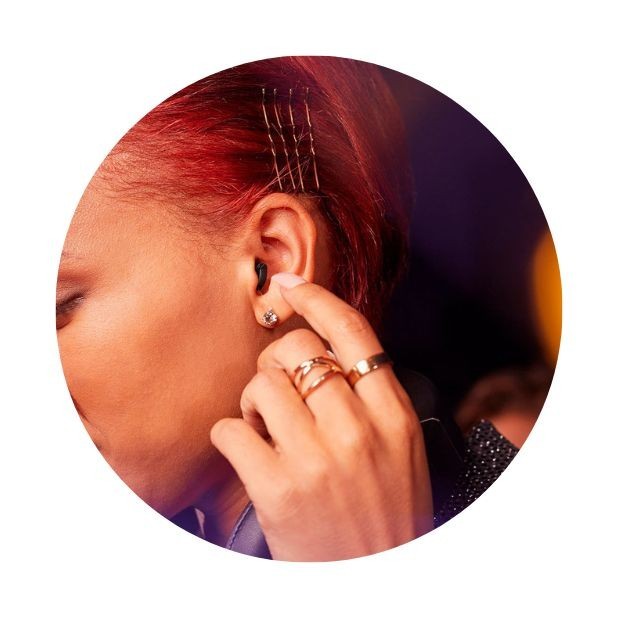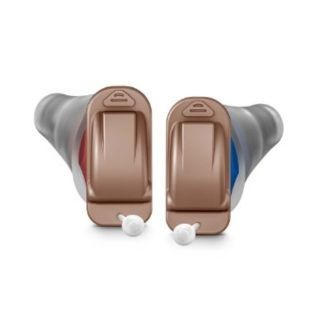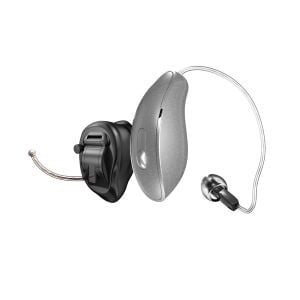Free home visits
with a local audiologist
Invisible hearing aids are also known as Invisible in the Canal. Invisible in the Canal (IIC) hearing aids are very similar to Completely in the Canal (CIC) hearing aids, except they are slightly smaller and are worn deeper in the ear canal, making them completely invisible - even if someone were to look inside your ear.
This means that the only way that someone would be able to tell if you are wearing this type of hearing aid is if you tell them! In this article, we explore the best invisible hearing aids on the market for 2025 as well as the pros and cons of this hearing aid type.
According to a recent study, up to 40% of people would be more likely to wear a hearing aid if it were completely invisible. In many ways, Invisible in the Canal (IIC) hearing aids have been designed with these wearers in mind.
Insertion and removal of invisible hearing aids is via a small wire that protrudes from the hearing aid to the outer part of your ear meaning that you can hold onto this when you are putting them in or taking them out.

Even though hearing aid technology has come on leaps and bounds, with a hearing aid that is small enough to fit entirely into your ear canal, there will have to be some compromises on things like battery size and the amount of technology that can be incorporated into invisible hearing aids.
This means that they are generally only suitable for people with mild to moderate hearing loss, as they usually can’t produce enough power for wearers with more severe hearing loss.
However, if discretion is your main priority, then invisible hearing aids could be a great option for you.

As with all hearing aid types, there are both advantages and disadvantages, and invisible hearing aids are no different. Below are some of the main pros and cons to think about when considering invisible hearing aids.
Because invisible hearing aids sit deep within the ear canal itself, it means that the receiver can almost directly interact with the eardrum, resulting in a much more natural sound profile.
As invisible hearing aids sit within the ear canal, the ear is left free to perform its natural function of channelling sound waves down towards the ear canal.
This is especially advantageous because it means that the natural directionality of the sound can still be communicated to the inner ear, resulting in wearers being much more able to detect the directionality of sounds, i.e. if someone is behind or to the side of you.
It would be impossible to put any controls directly onto an Invisible in the Canal (IIC) hearing aid. This means that all changes and adjustments have to be made remotely via a dedicated remote control device, some of which are small enough to fit on your key ring.
Because invisible hearing aids are made from a custom mould of your ear, they sit deeper in the ear canal and rest against a "bonier" part of your ear than a Completely in the Canal (CIC) hearing aid. This means that they sit very securely and comfortably and many wearers report being barely able to tell that they are there at all.

Reduced wind noise - As invisible hearing aids sit completely within the ear canal it means that issues of wind noise detection are reduced if not eliminated.
Natural telephone use - Compared to many other types of hearing aids, where a telephone has to be held slightly above or to the back of the ear to use, invisible hearing aids sit deep enough within the ear for you to use a phone in the usual position.
This can be a real bonus for many people who find adjusting to an unnatural feeling phone position very difficult.
Unobtrusive to helmets - The same reason that applies to being able to use phones naturally means that invisible hearing aids can easily be used whilst wearing helmets or other headgear. This makes them much more suitable for wearers with active lifestyles.

To be small enough to completely disappear, invisible hearing aids incorporate smaller processors and amplifiers. This means that they may not be able to deliver the power levels required for wearers with more severe hearing loss.
They also may not be able to accommodate some of the extra technological functions that you can find in some larger-sized hearing aids, and can only include one microphone. However, as mentioned above, they don’t tend to suffer from the directionality issues of other out-of-the-ear or Behind the Ear hearing aid types.
Because of their position, there is no option for communication between two invisible hearing aids. This means that if you wear two IIC hearing aids then each will have to be adjusted separately.
The smaller size of invisible hearing aids means that they are only able to accommodate the smallest battery sizes. This means that their batteries need to be changed much more frequently, and they are generally not able to provide the amplification power required for those with severe hearing loss.
Due to the position of invisible hearing aids within the ear canal itself, it is not possible to include any direct control buttons on the casing. This means that such things as adjustments need to be made via a remote device which may be off-putting or unsuitable for some wearers.
They also don’t have the option of Bluetooth connectivity to smartphone apps that could be used to control them.
Even with the insertion and removal wire that attaches to an invisible hearing aid, there is still a high level of dexterity required to put them in and take them out. This shouldn't pose a problem for most wearers; however, it could prove too difficult for those with compromised motor skills.
Due to their position within the ear canal, invisible hearing aids are more susceptible to damage from moisture within the ear and clogging up with earwax. If they are carefully and regularly cleaned, maintained, and dehumidified this should not cause you too many issues.
However, this level of maintenance may be unsuitable or off-putting for some wearers.

Invisible hearing aids can cause problems of occlusion as they completely block the ear canal. This results in symptoms such as hearing your own voice louder or sounding hollow, feeling that your ear is blocked, or chewing food that sounds noisy or unpleasant.
In some larger styles of hearing aids, this can be avoided by including a vent in the hearing aid, however, the small size of invisible hearing aids prevents this from being possible.
Unsuitable for some wearers - Invisible hearing aids are not suitable for all wearers, especially if they have particularly small or non-standard-shaped ear canals.
Costly - Compared to other styles of hearing aids that sit outside of the ear, invisible hearing aids can be some of the costliest on the market. However, some wearers feel that having a completely invisible hearing aid is well worth the cost.

Why did we pick these Starkey invisible hearing aids? The Starkey Signature Series 24 Invisible in the Canal (IIC) hearing aid utilises a size 10 disposable battery and stands out as one of the tiniest custom-made invisible hearing aids currently available.
Along with sticking to some proven technology features that have shown success with hearing aid wearers, they've also included some new ones since Evolv AI. For example, the processing chip update brings improvements in speed and capacity, loaded with five times more computational memory and ten times the amount of non-volatile memory.
Plus, with the introduction of Starkey's Neuro Sound Technology, which “fills in the gaps” hearing loss naturally takes away, you can benefit from a great hearing experience in whatever listening environment you find yourself in.
Pros of this invisible hearing aid
Cons of this invisible hearing aid
Why did we pick these Oticon invisible hearing aids? The Oticon OWN hearing aid includes BrainHearing technology and an onboard Deep Neural Network (DNN). This clever combination delivers exceptional sound quality and reduces the listening effort for individuals with mild to severe hearing loss.
Oticon also states that the fit of this hearing aid is so discreet that it's virtually invisible for nine out of 10 wearers.
Pros of this invisible hearing aid
Cons of this hearing aid
Why did we pick this invisible Signia hearing aid? Signia Silk IX hearing aids achieve a snug and dependable fit, thanks to the Click Sleeves that effortlessly attach to the hearing aids.
They provide great speech clarity, particularly in loud group conversations, even when voices move and alter position. As the device microphones are situated inside the ear canal, they offer a more natural listening experience whilst on phone calls and listening to other audio.
Pros of this invisible hearing aid
Cons of this invisible hearing aid
Invisible hearing aids are a good discreet option if you want the benefit of good hearing without visibility. They don't include external wires or tubes and they are super lightweight and comfortable.
However, they need more maintenance as it's easier to get moisture and earwax in this type of hearing aid. Putting batteries in and out might also cause problems for those where dexterity is a challenge.
So, if you are considering invisible hearing aids, make sure you speak with your audiologist to go through all the features, benefits, pros, and cons. This type of hearing aid is not for everyone, but with the right support, you can determine which device is the best for you and your hearing loss.
 Starkey Edge AI Hearing Aids VS Starkey Genesis AI
Starkey Edge AI Hearing Aids VS Starkey Genesis AI  Phonak Audeo Infinio VS Phonak Lumity Hearing Aids
Phonak Audeo Infinio VS Phonak Lumity Hearing Aids  What is Auracast? Is it better than Classic Bluetooth?
What is Auracast? Is it better than Classic Bluetooth? Do not spend hundreds of pounds without getting a second opinion from us.
 Not only are the prices great, but the service is fantastic! Many thanks to your team.
Not only are the prices great, but the service is fantastic! Many thanks to your team.If you are looking at this page then it is likely that an audiologist has suggested that you purchase this particular hearing aid, so is this the best model for you?
In general, any audiologist will always recommend to you the model that best suits your needs. Here is a useful checklist to make sure that is the case.
If in doubt, feel free to give us a call. That's what we're here for. In the meantime, read all about our review of the best hearing aids for 2025 here
If you have significant hearing loss in both ears, you should be wearing two hearing aids. Here are the audiological reasons why:
Localisation: The brain decodes information from both ears and compares and contrasts them. By analysing the minuscule time delays as well as the difference in the loudness of each sound reaching the ears, the person is able to accurately locate a sound source. Simply put, if you have better hearing on one side than the other, you can't accurately tell what direction sounds are coming from.
Less amplification is required: A phenomenon known as “binaural summation” means that the hearing aids can be set at a lower and more natural volume setting than if you wore only one hearing aid.
Head shadow effect: High frequencies, the part of your hearing that gives clarity and meaning to speech sounds, cannot bend around your head. Only low frequencies can. Therefore if someone is talking on your unaided side you are likely to hear that they are speaking, but be unable to tell what they have said.
Noise reduction: The brain has its own built-in noise reduction which is only really effective when it is receiving information from both ears. If only one ear is aided, even with the best hearing aid in the world, it will be difficult for you to hear in background noise as your brain is trying to retain all of the sounds (including background noise) rather than filtering it out.
Sound quality: We are designed to hear in stereo. Only hearing from one side sounds a lot less natural to us.
Fancy some further reading on this topic? You can read about why two hearing aids are better than one in our article, hearing aids for both ears, here
For most people, the main benefit of a rechargeable hearing aid is simple convenience. We are used to plugging in our phones and other devices overnight for them to charge up. Here are some other pros and cons:
For anybody with poor dexterity or issues with their fingers, having a rechargeable aid makes a huge difference as normal hearing aid batteries are quite small and some people find them fiddly to change.
One downside is that if you forget to charge your hearing aid, then it is a problem that can't be instantly fixed. For most a 30-minute charge will get you at least two or three hours of hearing, but if you are the type of person who is likely to forget to plug them in regularly then you're probably better off with standard batteries.
Rechargeable aids are also a little bit bigger and are only available in Behind the Ear models.
Finally, just like with a mobile phone, the amount of charge you get on day one is not going to be the same as you get a few years down the line. Be sure to ask what the policy is with the manufacturer warranty when it comes to replacing the battery.
Looking for more information on rechargeable hearing aids? Read our dedicated page on the topic here
For most people, the answer is yes. But it's never that simple.
The majority of hearing problems affect the high frequencies a lot more than the low ones. Therefore open fitting hearing aids sound a lot more natural and ones that block your ears up can make your own voice sound like you are talking with your head in a bucket. Therefore in-ear aids tend to be less natural.
However the true answer is we can't tell until we have had a look in your ears to assess the size of your ear canal, and until we have tested your hearing to see which frequencies are being affected.
People with wider ear canals tend to have more flexibility, also there are open fitting modular CIC hearing aids now that do not block your ears.
There is also the age old rule to consider, that a hearing aid will not help you if it's sat in the drawer gathering dust. If the only hearing aid you would be happy wearing is one that people can't see, then that's what you should get.
Most people can adapt to any type of hearing aid, as long as they know what to expect. Have an honest conversation with your audiologist as to what your needs are.
Generally speaking, six or more. Unless it's none at all.
The number of channels a hearing aid has is often a simplistic way an audiologist will use to explain why one hearing aid is better than another, but channels are complex and it is really not that straightforward. Here are some reasons why:
Hearing aids amplify sounds of different frequencies by different amounts. Most people have lost more high frequencies than low and therefore need more amplification in the high frequencies. The range of sounds you hear are split into frequency bands or channels and the hearing aids are set to provide the right amount of hearing at each frequency level.
Less than six channels and this cannot be done with much accuracy, so six is the magic number. However, a six channel aid is typically very basic with few other features and is suitable only for hearing a single speaker in a quiet room. The number of channels is not what you should be looking at, it's more the rest of the technology that comes with them.
As a final note, different manufacturers have different approaches. One method is not necessarily better than any other. For example, some manufacturers have as many as 64 channels in their top aids. Most tend to have between 17 and 20. One manufacturer has no channels at all.
Hearing aids are easily lost, misplaced or damaged and typically are one of the most expensive personal possessions an individual can own. We offer hearing aid warranty coverage for £80 per year per aid. Find out more about this service we provide here
All our audiologists use the very latest technology and provide the full range of tests to accurately measure your hearing for free. Find out about what hearing healthcare services we offer all our customers here
Hearing Aid UK offers all their customers free home visiting services, even in a care home environment, for no extra cost. Including hearing tests, fittings, maintenance, check-ups and much more in the comfort of your own home and at your convenience. Find out more information about our home visits here
Here, at Hearing Aid UK, we are dedicated to offering low hearing aid prices. We achieve this by having no head office and low marketing costs. Our hearing aid prices are amongst the lowest you will find anywhere in the world. Explore our prices, brands, and models here
When we refer to a product as 'Latest Launch', we mean it is the latest to be released on the market.
When we refer to a product as 'New', we mean that the product is the newest hearing aid model on the market.
When we refer to a product as 'Superseded', we mean that there is a newer range available which replaces and improves on this product.
When we refer to a product as an 'Older Model', we mean that it is has been superseded by at least two more recent hearing aid ranges.